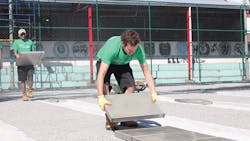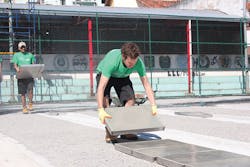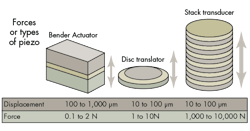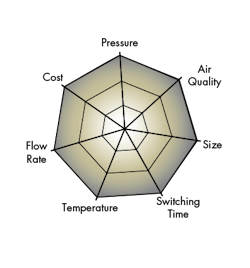This file type includes high resolution graphics and schematics when applicable.
Although electronics are getting smaller and using less power, other mechanisms and hardware might not be able to follow suit. Undeterred by this prospect, designers are using the piezoelectric effect to continue shrinking products.
Bending Actuators
The converse piezoelectric effect uses an electric field to generate deformation. It is used for actuators and transducers. Bending actuators are normally laminated materials—often a ceramic or quartz layered with a passive, conductive substrate formed into rectangles that bend when electricity is applied. One application is in piezoelectric valves for precise medical and laboratory devices.
Using bending actuators to open and close valves offers several benefits. For one, the operating power is reduced compared to solenoid valves. Solenoids are held closed by compression springs. Once the valve opens, it takes continuous power to resist the energy of this spring. A piezoelectric valve uses just enough energy (often called the switch-on energy) to charge and deform the actuator material. After power is removed, the valve stays open until actively discharged. The switch-on energy is relatively simple to calculate:
E=CU2/2
where:
E = energy;
C = capacitance of the transducer;
U = the control voltage.
The capacitance is generally about 30 nanofarads, and the control voltage can be up to 300 V; that means the switch-on energy normally lies between 0.5 to 5 milli-Watt seconds (switch on energy is always presented in mWs).
Instead of closing the valve by grounding out the charge in the material, the energy can discharge into a capacitor or energy recovery device. This technique recovers up to 50% of the energy needed to open the valve. By recovering the energy some applications save up to 95% in power.
“Piezovalves work great for portability,” says Sam Stoney, Festo’s medical device specialist. “In one application, solenoids were used with AA batteries for portable supplemental oxygen. But the batteries only lasted about a month. When we redesigned it with our piezovalves, the life of the batteries was extended by over two years.”
Solenoids still make up the majority of the valve market. That’s because piezoelectronics offer control only up to about 44 psi and flows to about 6.6 gal/min. While direct-acting solenoids achieve pressures of over 400 psi, that control flows of hundreds of gallons per minute. “But the sweet spot is getting broader as more piezoelectric valves are released to market,” says Stoney. “For example, some piezoelectric valves can now reach 150 psi.”
Piezoelectric valves can often simplify equipment while reducing cost, energy, and size. “But piezoelectric valves likely won’t ever replace solenoid valves,” Stoney notes. “Solenoid valves have staying power because they’re relatively inexpensive, reliable, and simple to understand. Its design is proven and effective.”
Piezoelectronics valves might be used instead of solenoids when heat buildup is a concern. For lab and medical applications where precision is required, the metal components—specifically, the spring keeping the valve closed—can negatively impact repeatability and accuracy. Thermal expansion of metal components can change the pressure required to open the valve, called the cracking pressure.
Engineers can compensate for thermal concentrations with different techniques, but when using piezoelectronics, the problem is circumvented. Due to the minimum energy used in activating piezovalves and actuators, any thermal concentrations are usually nominal. In addition, applications with multiple solenoids generate heat concentrations that could reach temperatures that might degrade materials around it.
It is important to understand how piezoelectronics work when designing devices such as valves. For example, it is possible to vary the electric field to control actuators. “Piezoelectronics make great proportional valves,” says Stoney. “The wider you need to open a piezovalve, the more power you need. Using piezovalves as a low power alternative for mobile uses, or to add control in a process by using it as a proportional valve, are a couple ways piezovalves have excelled.”
Disk and Stack Actuators
Disk actuators are similar to bending actuators, except arranged in a disk. With the piezo-materials in the middle and a passive, conductive substrate along the outside, an electric charge causes the ceramic to expand in the direction of the electric field. This normally makes the disk thicker and the diameter smaller. Over-all, a spherical bend occurs which makes the disk actuator work well in high-frequency speakers, ultrasounds generators, and automotive distance sensors.
Stacked actuators, also called piezo-stacks, use the material’s expansion rather than its bending reaction. This creates actuating forces up to10 kN and 0.2% (maximum) change in overall height. The minimal displacement limits its applications. However, Maurizio Porfiri, a professor at New York University’s Tandon School of Engineering, notes that, “Researchers have experimented with integrating piezo-stacks into mechanical structures, such as trusses, to create active joints that reduce structural vibrations.”
Design Considerations
Safety is always a concern. Emergency stops (E-stop) normally shut off power to machinery, causing components to stop working or valves to close. With the piezoelectric effect, material acts like a capacitor and hold its charge—keeping its shape and for piezoelectric valves this means staying open. It is important to determine whether leaving a valve open could lead to a safety concern. To ensure valves close, a resistor in parallel with the valve could discharge it slowly, or a single-pole, double-throw relay could ground the circuit, depending on application. However, these devices might make the system more complicated and hinder the benefit of the piezoelectric’s efficiency.
Many electrical systems operate off 12 to 24 V. Piezoelectric can use up to 300 V, which sounds like a safety concern. However, few amps (often in the milli-amps range) are needed, so piezoelectronics are intrinsically safe.
Piezoelectronics also last a long time: Up to a billion cycles are possible if designed properly. Designers know many sensors, actuators, and valves are made of brittle materials. If they are switched too quickly to fully open, they can slam into the end stop, lowering the material’s operational life. It’s preferable for applications to have transducers or actuators that slow before hitting end stops, or else never hit them. Designers can change switching speeds by changing the resistance. Unfortunately, they can’t get all of the benefits of piezoelectronics in one product. Motion can be fast or smooth, but not both.
The main idea to keep in mind when designing with piezoelectronics is to exploit their low power, low temperature, and proportional response. Don’t design piezoelectric-devices as you would solenoids. “It’s like when engineers started using robotics to replace humans,” says Stoney. “They designed the robot to act like a human; the result was inefficient. Once engineers started designing robots like robots, their efficiency greatly increased.
“When designing with piezoelectrics, ask yourself if you want to turn something on and off, or something else. If you want something else, you might want to look into piezoelectronics.”
Trends in Piezoelectronics
piezoelectric actuators also work as transducers. The direct piezoelectric effect is able to generate an electric field from mechanical deformation. It is often used as a sensor to detect force, acceleration, shock, and more. Piezoelectric sensors can be designed to handle a relatively wide range of forces.
New efficient electronics and a desire for obtaining operating information remotely are opening the door to use piezoelectronics for energy harvesting. This technology will not be running power plants. Just as the piezo-actuators use only milliamps, some harvesting electronics are only registering nano-amps. However, for some applications that’s sufficient. As IoT and remote sensing become more popular and electronics need less energy to operate, the direct piezoelectric effect is being research as a viable power source for future device that do not have an easily accessible power source.
Porfiri has showed how piezoelectric technology can generate electricity from vibrations caused by oscillating flows, impacting vortices, or underwater oscillations. “Power-harvesting piezoelectrics could provide a sustainable power source to operate sensors,” he says. “Engineers and scientists are aggressively researching materials science to engineer efficient and performing devices, such as micro-fiber composites called MFCs. They could lead to flexible fabrics that control a material’s deformation, or let the deformation generate electricity.”
This technology can allow for aquatic animals to be tagged with a sensor that has a sustainable power source, as long as the animal or water is moving. Not only could this revolutionize underwater electronics, but with the growth of the mobility and IoT markets, piezoelectric technology could have some interesting future applications.
For remote and longer-term sensing and data applications a battery can lose power and eventually need to be replaced. A piezoelectric generator, on the other hand, could be without a charge for an extended period of time, and as soon as an outside force acts on it the generator is able to start producing power again. If the electronics are still functioning, you will start collecting data again—even if years have passed.
The Piezoelectric Effect
Crystalline structures got a lot more interesting around 1880, when Pierre and Jacques Curie discovered the piezoelectric effect. They found out that after polarizing crystalline structures like quartz, tourmaline, and even salt—and subjecting them to mechanical stress— they generated a small electric current. The phenomenon was named piezoelectricity (from the Greek word piezien or pizo, meaning to push or press).
Crystalline materials can be polarized by a high voltage, often several kV/mm that causes molecules to align, changing the material’s shape. For example, a square might become a thinner and taller rectangle when electricity is applied. When the voltage is switched off, the material retains its new shape. If the charge is actively removed by grounding it or passing the charge to an energy recovery device, the shape mostly returns to its original size. Some molecules remain aligned while others return to their original position, thanks to internal mechanical stresses.
The piezoelectric effect can work in two ways. In the direct piezoelectric effect, stress applied to a material creates an electric field. In the converse piezoelectric effect, which was discovered in 1881 by Gabriel Lippmann, an electric field causes the material to deform.
This file type includes high resolution graphics and schematics when applicable.






